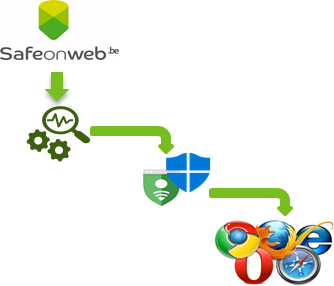Suspicious@safeonweb.be is an e-mail address of the Centre for Cyber Security Belgium (CCB).
The purpose of suspicious@safeonweb.be is simple: we call on internet users who voluntarily alert us when they receive a suspicious message, a so-called phishing message, by forwarding this message to suspicious@safeonweb.be. We will then check the links and attachments of these forwarded messages. This process is fully automated. We will then have suspicious links blocked. In this way, less attentive internet users who have clicked on the link are also protected.
I am forwarding messages to suspicious@safeonweb.be but what will happen to them?
Every day, we receive thousands of suspicious emails. In 2024, 9,000,000 messages were forwarded to suspicious@safeonweb.be. The suspicious URLs from these emails are sent to Google SafeBrowsing and Microsoft SmartScreen. Browsers use this information to warn visitors about malicious websites.
Can I also forward suspicious text messages?
Suspicious text messages can also be forwarded to suspicious@safeonweb.be. All you have to do is take a screenshot and forward it. Our technology can detect the links in those images. If the links point to malicious web pages, we can have those pages blocked.
I do not get a personal reply when I forward a message. Is that normal?
You will indeed not get a personal reply. We do not answer if your forwarded message was a phishing message. When you forward a suspicious message to suspicious@safeonweb.be, we reply with an acknowledgment. This is an automatic response to confirm that we have received your message correctly and explains what we will do with it. Forwarded messages to suspicious@safeonweb.be allow us to block fake URLs in the message so that less attentive internet users do not fall into the trap. If you have any doubts about the authenticity of the message, chances are that it is indeed a phishing message. If you think the message may be genuine, contact the sender by phone for more information. Do not call the numbers mentioned in the message you have doubts about, but look for the right number yourself.
I am forwarding messages to suspicious@safeonweb.bebut I keep getting phishing e-mails? How is that possible?
If you forward a suspicious message, you are mainly helping attentive internet users. If users do not notice that a message is suspicious and they click on the link anyway, they will not be able to reach the suspicious website.
To receive fewer annoying phishing messages yourself, check out our tips at:
https://safeonweb.be/en/i-am-getting-lot-spam-and-phishing-e-mails-my-inbox
I am unable to forward messages to suspicious@safeonweb.be. How is that possible?
Sometimes, people type a mistake in the email address. Check the spelling and then it will probably work.
I sometimes get a message that my message cannot be sent to suspicious@safeonweb.be. What is going wrong?
Sometimes there are problems with forwarding messages. Your mailbox may mistake you for someone who is sending spam or phishing messages. This is the case when the message you want to forward is already known as a phishing message.
When should I forward messages?
You should forward suspicious messages as soon as possible. The sooner we act, the fewer victims are made.
Do I put myself at risk by forwarding messages?
You do not run any risk by forwarding a suspicious message. Be careful and do not unintentionally click on a link or attachment in a suspicious message. The CCB is not responsible for any mistakes made by users.
* Data protection
The CCB, as the national authority in charge of cyber security in Belgium, ensures that the legal provisions in the area of the security of personal data and electronic communication are complied with. If you have any questions about this topic, you can send them to the following e-mail address privacy@ccb.belgium.be
General information: BePhish
We are moving towards an increasingly digital world. The security and reliability of online communications are essential to our economic and social life. Phishing is a common online threat. Cybercriminals are becoming increasingly creative in their attempts to deceive people: they send fake messages so realistic that you open the attachment; they promise a big reward if you complete a survey and leave your details; they threaten you if you don't respond and, finally, they use an increasing number of channels (e-mail, WhatsApp, Messenger, etc.).
BePhish is a project set up by the Centre for Cybersecurity Belgium (CCB) and its operational component (CERT). Using the e-mail address suspect@safeonweb.be, the CCB is calling on all Internet users to forward suspicious messages to it. The links and attachments are automatically analysed and, if found to be malicious, forwarded to be blocked in browsers.
BePhish design
Four email addresses are available
These e-mail addresses can be used by Internet users to forward suspicious messages. Attachments and links are extracted from suspicious messages. URLs are also extracted from screenshots. URLs and attachments are then analysed automatically. In the case of attachments, the analysis is carried out using a sandbox environment. If the analysis shows that a URL is malicious, it is passed on to Google Safe Browsing and Microsoft Smartscreen. These two lists of malicious websites are used by most browsers to provide a warning at browser level. Internet users are thus warned if they have clicked on a malicious link.

